Studer D-19 Mic VALVE Owners manual
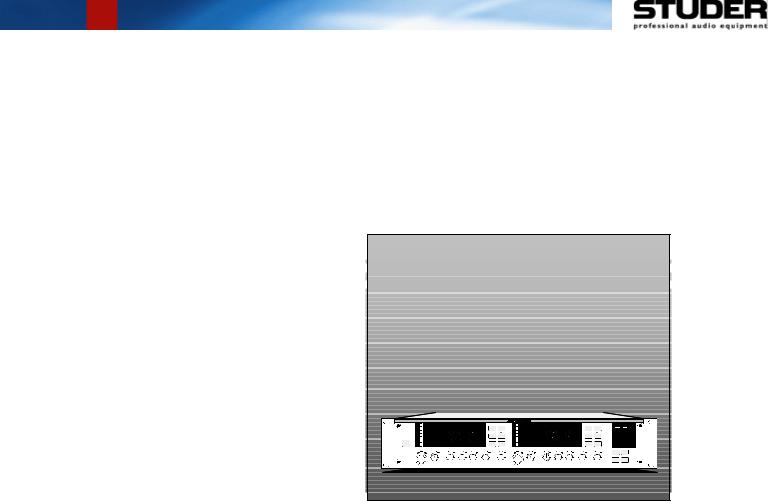
MicVALVE |
|
|
|
|
|
|
|
|
|
|
|
|
|
|
|
|
|
D19 SERIES |
|
|
OVL-1 |
1 |
VALVE |
|
|
|
VALVE |
48 V |
OVL-1 |
1 |
VALVE |
|
|
|
VALVE |
48 V |
HOLD |
SOFT |
|
|
--63 |
2 |
|
|
|
|
|
|
--63 |
2 |
|
|
|
|
|
|
|
||
|
-9 |
3 |
INS |
|
|
|
|
|
-9 |
3 |
INS |
|
|
|
|
|
|
|
|
|
-12 |
4 |
PRE |
|
|
|
INSERT |
|
-12 |
4 |
PRE |
|
|
|
INSERT |
|
|
INT |
48 |
|
-18 |
|
|
|
|
|
-18 |
|
|
|
|
|
|
||||||
POWER |
-24 |
5 |
|
|
|
|
|
|
-24 |
5 |
|
|
|
|
|
|
16DI |
WCLK |
44 |
|
-30 |
6 |
48 V |
|
|
|
ROUTING |
Ø |
-30 |
6 |
48 V |
|
|
|
ROUTING |
Ø |
16NS |
AES |
VAR |
|
-40 |
7 |
|
|
|
|
|
|
-40 |
7 |
|
|
|
|
|
|
20BIT |
AUTO |
|
|
-60 |
8 |
Ø |
|
|
|
|
|
-60 |
8 |
Ø |
|
|
|
|
|
|
|
|
|
Input |
|
Fine |
Bass |
Angel |
|
Valve Drive |
Line |
|
Input |
Fine |
Bass |
Angel |
|
Valve Drive |
Line |
MODE |
SYNC |
|
|
dBu FS |
|
Gain |
Warmth |
Zoom |
Gain |
Clip |
Out |
dBu FS |
Gain |
Warmth |
Zoom |
Gain |
Clip |
Out |
|
|||
|
|
|
|
|
|
|
|
|
|
|
|
|
|
|
|
|
PEAK HOLD SOFT CLIP |
||
|
|
|
|
|
LEFT |
|
|
|
|
|
|
|
RIGHT |
|
|
|
|
|
|
D19 MicVALVE
Valve-Dignified Mic/Line Preamplifier
Betriebsanleitung
Operating Instructions
Prepared and edited by |
Copyright by Studer Professional Audio AG |
Studer Professional Audio AG |
Printed in Switzerland |
Technical Documentation |
Order no. 10.27.3861 (Ed. 0497) |
Althardstrasse 30 |
|
CH-8105 Regensdorf – Switzerland |
|
http://www.studer.ch |
Subject to change |
|
|
Studer is a registered trade mark of Studer Professional Audio AG, Regensdorf |
|
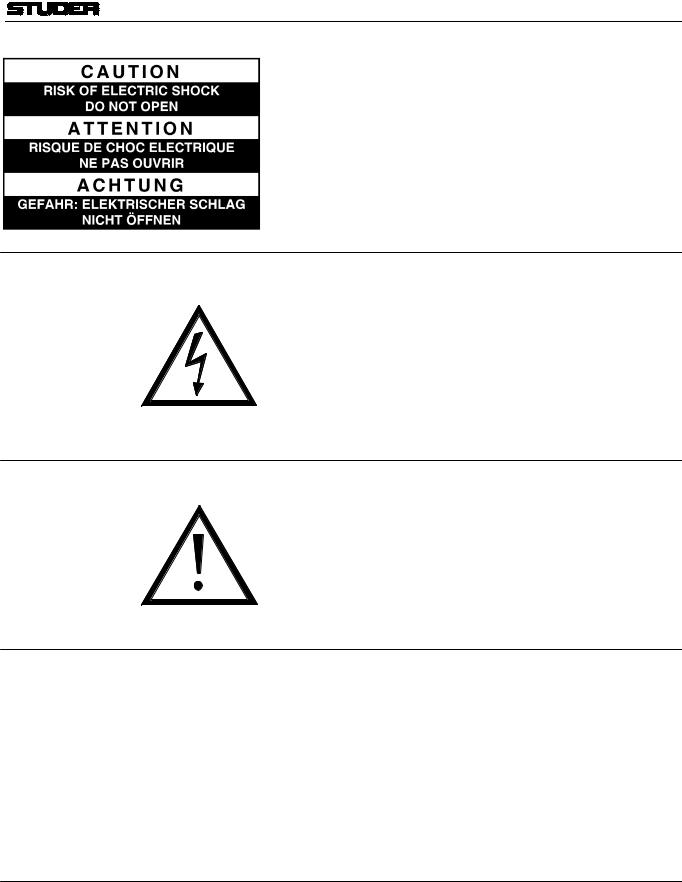
SAFETY / SECURITE / SICHERHEIT
To reduce the risk of electric shock, do not remove covers (or back). No user-serviceable parts inside. Refer servicing to qualified service personnel.
Afin de prévenir un choc électrique, ne pas enlever les couvercles (où l’arrière) de l’appareil. Il ne se trouve à l’intérieur aucune pièce pouvant être réparée par l’usager.
Um die Gefahr eines elektrischen Schlages zu vermeiden, entfernen Sie keine Geräteabdeckungen (oder die Rückwand). Überlassen Sie Wartung und Reparatur qualifiziertem Fachpersonal.
This symbol is intended to alert the user to presence of uninsulated “dangerous voltage” within the apparatus that may be of sufficient magnitude to constitute a risk of electric shock to a person.
Ce symbole indique à l'utilisateur qu'il existent à l'intérieur de l'appareil des “tensions dangereuses”. Ces tensions élevées entrainent un risque de choc électrique en cas de contact.
Dieses Symbol deutet dem Anwender an, dass im Geräteinnern die
Gefahr der Berührung von “gefährlicher Spannung” besteht. Die
Grösse der Spannung kann zu einem elektrischen Schlag führen.
This symbol is intended to alert the user to the presence of important instructions for operating and maintenance in the enclosed documentation.
Ce symbole indique à l’utilisateur que la documentation jointe contient d'importantes instructions concernant le fonctionnement et la maintenance.
Dieses Symbol deutet dem Anwender an, dass die beigelegte Dokumentation wichtige Hinweise für Betrieb und Wartung enthält.
CAUTION: Lithium battery. Danger of explosion by incorrect handling. Replace by battery of the same make and type only.
ATTENTION: Pile au lithium. Danger d'explosion en cas de manipulation incorrecte. Ne remplacer que par un modèle de même type.
ACHTUNG: Explosionsgefahr bei unsachgemässem Auswechseln der Lithiumbatterie. Nur durch den selben Typ ersetzen.
ADVARSEL: Lithiumbatterei. Eksplosinsfare. Udskinftning ma kun foretages af en sagkyndig of som beskrevet i servicemanualen (DK).
I

SAFETY / SECURITE / SICHERHEIT
FIRST AID
(in case of electric shock)
1.Separate the person as quickly as possible from the electric
power source:
•by switching off the equipment
•or by unplugging or disconnecting the mains cable
•pushing the person away from the power source by using dry insulating material (such as wood or plastic).
•After having sustained an electric shock, always consult a doctor.
WARNING!
DO NOT TOUCH THE PERSON OR HIS CLOTHING BEFORE THE POWER IS TURNED OFF, OTHERWISE YOU STAND THE RISK OF SUSTAINING AN ELECTRIC SHOCK AS WELL!
2. If the person is unconscious:
•check the pulse,
•reanimate the person if respiration is poor,
•lay the body down, turn it to one side, call for a doctor immediately.
PREMIERS SECOURS
(en cas d'électrocution)
1.Si la personne est dans l'impossibilité de se libérer:
•Couper l'interrupteur principal
•Couper le courant
•Repousser la personne de l'appareil à l'aide d'un objet en matière non conductrice (matière plastique ou bois)
•Après une électrocution, toujours consulter un médecin.
ATTENTION!
NE JAMAIS TOUCHER UNE PERSONNE QUI EST SOUS TENSION, SOUS PEINE DE SUBIR EGALEMENT UNE ELECTROCUTION.
2. En cas de perte de connaissance de la personne électrocutée:
•Controller le pouls
•Si nécessaire, pratiquer la respiration artificielle
•Placer l'accidenté sur le flanc et consulter un médecin.
ERSTE HILFE
(bei Stromunfällen)
1.Bei einem Stromunfall die betroffene Person so rasch wie
möglich vom Strom trennen:
•Ausschalten des Gerätes
•Ziehen oder Unterbrechen der Netzzuleitung
•Betroffene Person mit isoliertem Material (Holz, Kunststoff) von der Gefahrenquelle wegstossen
•Nach einem Stromunfall sollte immer ein Arzt aufgesucht werden.
ACHTUNG!
EINE UNTER SPANNUNG STEHENDE PERSON DARF NICHT BERÜHRT WERDEN. SIE KÖNNEN DABEI SELBST ELEKTRISIERT WERDEN!
2. Bei Bewusstlosigkeit des Verunfallten:
•Puls kontrollieren,
•bei ausgesetzter Atmung künstlich beatmen,
•Seitenlagerung des Verunfallten vornehmen und Arzt verständigen.
II
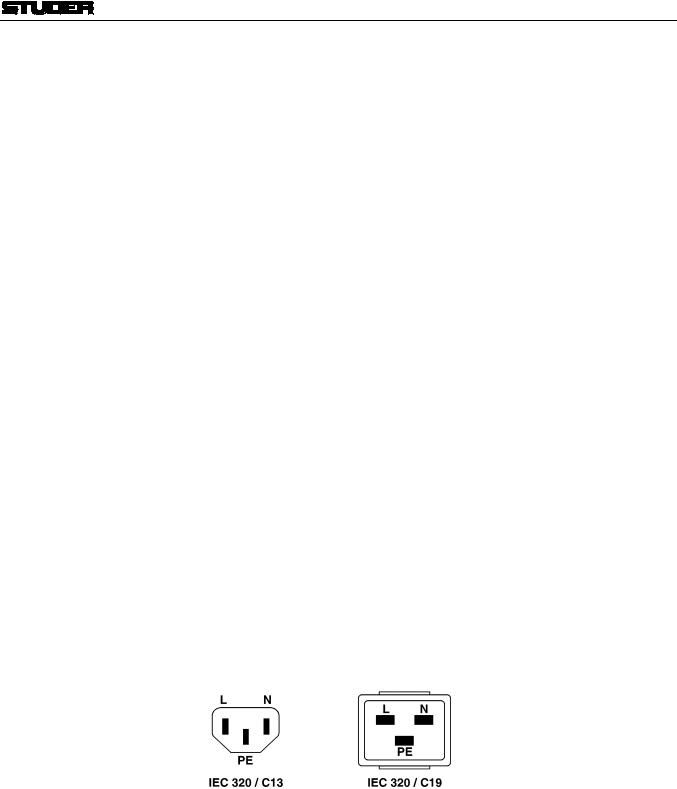
SICHERHEIT / SAFETY
Installation |
|
Installation |
Vor der Installation des Gerätes müssen die hier aufgeführten und auch die weiter in dieser Anleitung mit  bezeichneten Hinweise gelesen und während der Installation und des Betriebes beachtet werden.
bezeichneten Hinweise gelesen und während der Installation und des Betriebes beachtet werden.
Untersuchen Sie das Gerät und sein Zubehör auf allfällige Transportschäden.
Ein Gerät, das mechanische Beschädigung aufweist oder in welches Flüssigkeit oder Gegenstände eingedrungen sind, darf nicht ans Netz angeschlossen oder muss sofort durch Ziehen des Netzsteckers vom Netz getrennt werden. Das Öffnen und Instandsetzen des Gerätes darf nur von Fachpersonal unter Einhaltung der geltenden Vorschriften durchgeführt werden.
Falls dem Gerät kein konfektioniertes Netzkabel beiliegt, muss dieses durch eine Fachperson unter Verwendung der mitgelieferten Kabel-Gerätedose IEC320/C13 oder IEC320/C19 und unter Berücksichtigung der einschlägigen, im geweiligen Lande geltenden Bestimmungen angefertigt werden; siehe unten.
Vor Anschluss des Netzkabels an die Netzsteckdose muss überprüft werden, ob die Stromversorgungsund Anschlusswerte des Gerätes (Netzspannung, Netzfrequenz) innerhalb der erlaubten Toleranzen liegen. Die im Gerät eingesetzten Sicherungen müssen den am Gerät angebrachten Angaben entsprechen.
Ein Gerät mit einem dreipoligen Gerätestecker (Gerät der Schutzklasse I) muss an eine dreipolige Netzsteckdose angeschlossen und somit das Gerätegehäuse mit dem Schutzleiter der Netzinstallation verbunden werden (Für Dänemark gelten Starkstrombestimmungen, Abschnitt 107).
Before you install the equipment, please read and adhere to the following recommendations and all sections of these instructions marked with  .
.
Check the equipment for any transport damage.
A unit that is mechanically damaged or which has been penetrated by liquids or foreign objects must not be connected to the AC power outlet or must be immediately disconnected by unplugging the power cable. Repairs must only be performed by trained personnel in accordance with the applicable regulations.
Should the equipment be delivered without a matching mains cable, the latter has to be prepared by a trained person using the attached female plug (IEC320/C13 or IEC320/C19) with respect to the applicable regulations in your country - see diagram below.
Before connecting the equipment to the AC power outlet, check that the local line voltage matches the equipment rating (voltage, frequency) within the admissible tolerance. The equipment fuses must be rated in accordance with the specifications on the equipment.
Equipment supplied with a 3-pole appliance inlet (equipment conforming to protection class I) must be connected to a 3-pole AC power outlet so that the equipment cabinet is connected to the protective earth conductor of the AC supply (for Denmark the Heavy Current Regulations, Section 107, are applicable).
|
|
|
|
Female plug (IEC320), view from contact side: |
|
|
|
L |
live; brown |
National American Standard: |
Black |
N |
neutral; blue |
|
White |
PE |
protective earth; green and yellow |
|
green |
Connecteur femelle (IEC320), vue de la face aux contacts: |
|
|
|
L |
phase; brun |
Standard national américain: |
Noir |
N |
neutre; bleu |
|
Blanc |
PE |
terre protective; vert et jaune |
|
Vert |
Ansicht auf Steckkontakte der Kabel-Gerätesteckdose (IEC320): |
|
|
|
L |
Phase; braun |
USA-Standard: |
Schwarz |
N |
Nulleiter; blau |
|
Weiss |
PE |
Schutzleiter; gelb/grün |
|
grün |
III
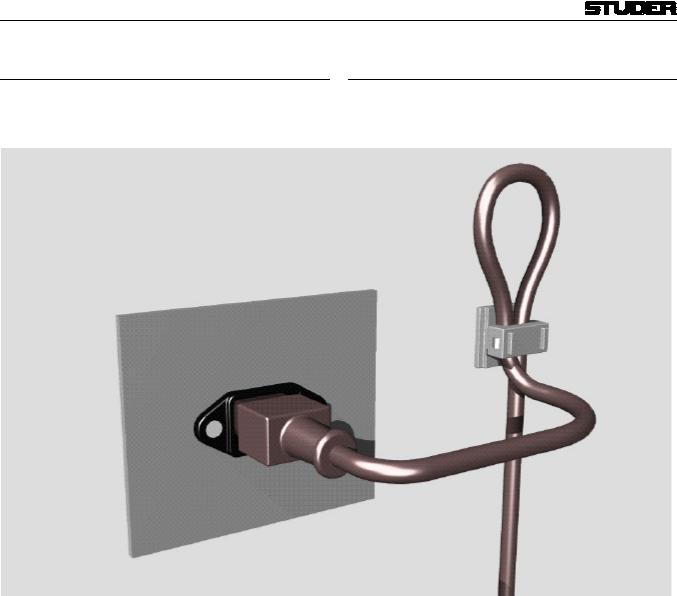
SICHERHEIT / SAFETY
Zugentlastung für den Netzanschluss
Zum Verankern von Steckverbindungen ohne mechanische Verriegelung (z.B. IEC-Kaltgerätedosen) empfehlen wir die folgende Anordnung:
Vorgehen: Der mitgelieferte Kabelhalter ist selbstklebend. Bitte beachten Sie bei der Montage die folgenden Regeln:
1.Der Untergrund muss sauber, trocken und frei von Fett, Öl und anderen Verunreinigungen sein. Temperaturbereich für optimale Verklebung: 20...40° C.
2.Entfernen Sie die Schutzfolie auf der Rückseite des Kabelhalters und bringen sie ihn mit kräftigem Druck an der gewünschten Stelle an. Lassen sie ihn unbelastet so lange wie möglich ruhen – die maximale Klebekraft ist erst nach rund 24 Stunden erreicht.
3.Die Stabilität des Kabelhalters wird erhöht, wenn Sie ihn zusätzlich verschrauben. Zu diesem Zweck liegen ihm eine selbstschneidende Schraube sowie eine M4-Schraube mit Mutter bei.
4.Legen Sie das Kabel gemäss Figur in den Halter ein und pressen Sie die Klemme kräftig auf, bis das Kabel fixiert ist.
Mains connector strain relief
For anchoring connectors without a mechanical lock (e.g. IEC mains connectors), we recommend the following arrangement:
Procedure: The cable clamp shipped with your unit is auto-adhesive. If mounting, please follow the rules below:
1.The surface to be adhered to must be clean, dry, and free from grease, oil or other contaminants. Best application temperature range is 20...40° C.
2.Remove the plastic protective backing from the rear side of the clamp and apply it firmly to the surface at the desired position. Allow as much time as possible for curing. The bond continues to develop for as long as 24 hours.
3.For improved stability, the clamp can be fixed with a screw. For this purpose, a self-tapping screw and an M4 bolt and nut are included.
4.Place the cable into the clamp as shown in the illustration above and firmly press down the internal top cover until the cable is fixed.
IV
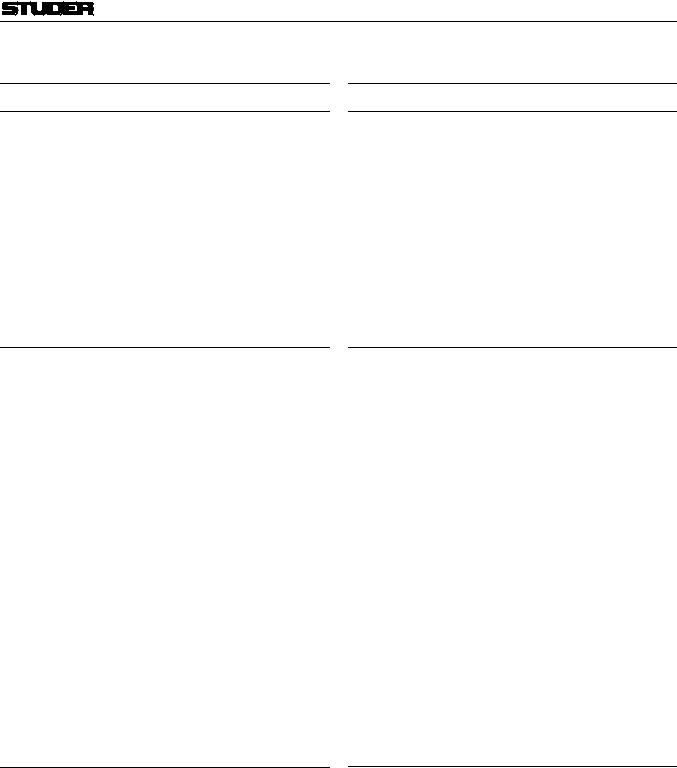
UMGEBUNGSBEDINGUNGEN / AMBIENT CONDITIONS
Lufttemperatur und Feuchtigkeit
Allgemein
Die Betriebstauglichkeit des Gerätes oder Systems ist unter folgenden Umgebungsbedingungen gewährleistet:
EN 60721-3-3, Set IE32, Wert 3K3.
Diese Norm umfasst einen umfassenden Katalog von Parametern; die wichtigsten davon sind: Umgebungstemperatur +5...+40 °C; rel. Luftfeuchtigkeit 5...85% – d.h. weder Kondensation noch Eisbildung; abs. Luftfeuchtigkeit 1...25 g/m³; Tem- peratur-Änderungsrate < 0,5 °C/min. In den folgenden Abschnitten wird darauf näher eingegangen.
Unter den genannten Bedingungen startet und arbeitet das Gerät oder System problemlos. Ausserhalb dieser Spezifikationen möglicherweise auftretende Probleme sind in den folgenden Abschnitten beschrieben.
Umgebungstemperatur
Geräte und Systeme von Studer sind allgemein für einen Umgebungstemperaturbereich (d.h. Temperatur der eintretenden Kühlluft) von +5...+40 °C ausgelegt. Bei Installation in einem Schrank muss der vorgesehene Luftdurchsatz und dadurch die Konvektionskühlung gewährleistet sein. Folgende Tatsachen sind dabei zu berücksichtigen:
1.Die zulässige Umgebungstemperatur für den Betrieb der Halbleiter-Bauelemente beträgt 0 °C bis +70 °C (commercial temperature range for operation).
2.Der Luftdurchsatz der Anlage muss gewährleisten, dass die austretende Kühlluft ständig kühler ist als 70 °C.
3.Die mittlere Erwärmung der Kühlluft soll 20 K betragen, die maximale Erwärmung an den heissen Komponenten darf somit um weitere 10 K höher liegen.
4.Zum Abführen einer Verlustleistung von 1 kW bei dieser
zulässigen mittleren Erwärmung ist eine Luftmenge von 2,65 m³/min notwendig.
Beispiel: Für ein Rack mit einer Leistungsaufnahme P = 800 W ist eine Kühlluftmenge von 0,8 * 2,65 m³/min nötig, entsprechend 2,12 m³/min.
5. Soll die Kühlfunktion der Anlage (z.B. auch bei LüfterAusfall oder Bestrahlung durch Spotlampen) überwacht werden, so ist die Temperatur der Abluft unmittelbar oberhalb der Einschübe an mehreren Stellen im Rack zu messen; die Ansprechtemperatur der Sensoren soll 65 bis 70 °C betragen.
Reif und Tau
Das unversiegelte System (Steckerpartien, Halbleiteranschlüsse) verträgt zwar leichte Eisbildung (Reif). Mit blossem Auge sichtbare Betauung führt jedoch bereits zu Funktionsstörungen. In der Praxis kann mit einem zuverlässigen Betrieb der Geräte bereits im Temperaturbereich ab –15 °C gerechnet werden, wenn für die Inbetriebnahme des kalten Systems die folgende allgemeine Regel beachtet wird:
Wird die Luft im System abgekühlt, so steigt ihre relative Feuchtigkeit an. Erreicht diese 100%, kommt es zu Niederschlag, meist in der Grenzschicht zwischen der Luft und einer kühleren Oberfläche, und somit zur Bildung von Eis oder Tau an empfindlichen Systemstellen (Kontakte, IC-Anschlüsse etc.). Ein störungsfreier Betrieb mit interner Betauung, unabhängig von der Temperatur, ist nicht gewährleistet.
Air temperature and humidity
General
Normal operation of the unit or system is warranted under the following ambient conditions defined by:
EN 60721-3-3, set IE32, value 3K3.
This standard consists of an extensive catalogue of parameters, the most important of which are: ambient temperature +5...
+40° C, relative humidity 5...85% – i.e. no formation of condensation or ice; absolute humidity 1...25 g/m³; rate of temperature change < 0,5 °C/min. These parameters are dealt with in the following paragraphs.
Under these conditions the unit or system starts and works without any problem. Beyond these specifications, possible problems are described in the following sections.
Ambient temperature
Units and systems by Studer are generally designed for an ambient temperature range (i.e. temperature of the incoming air) of +5...+40 °C. When rack mounting the units, the intended air flow and herewith adequate cooling must be provided. The following facts must be considered:
1.The admissible ambient temperature range for operation of the semiconductor components is 0 °C to +70 °C (commercial temperature range for operation).
2.The air flow through the installation must provide that the outgoing air is always cooler than 70 °C.
3.Average heat increase of the cooling air shall be 20 K, allowing for an additional maximum 10 K increase at the hot components.
4.In order to dissipate 1 kW with this admissible average heat increase, an air flow of 2,65 m³/min is required.
Example: A rack dissipating P = 800 W requires an air flow of
0,8 * 2,65 m³/min which corresponds to 2,12 m³/min.
5. If the cooling function of the installation must be monitored (e.g. for fan failure or illumination with spot lamps), the outgoing air temperature must be measured directly above the modules at several places within the rack. The trigger temperature of the sensors should be 65 to 70 °C.
Frost and dew
The unsealed system parts (connector areas and semiconductor pins) allow for a minute formation of ice or frost. However, formation of dew visible with the naked eye will already lead to malfunctions. In practice, reliable operation can be expected in a temperature range above –15 °C, if the following general rule is considered for putting the cold system into operation:
If the air within the system is cooled down, the relative humidity rises. If it reaches 100%, condensation will arise, usually in the boundary layer between the air and a cooler surface, together with formation of ice or dew at sensitive areas of the system (contacts, IC pins, etc.). Once internal condensation occurs, troublefree operation cannot be guaranteed, independent of temperature.
V
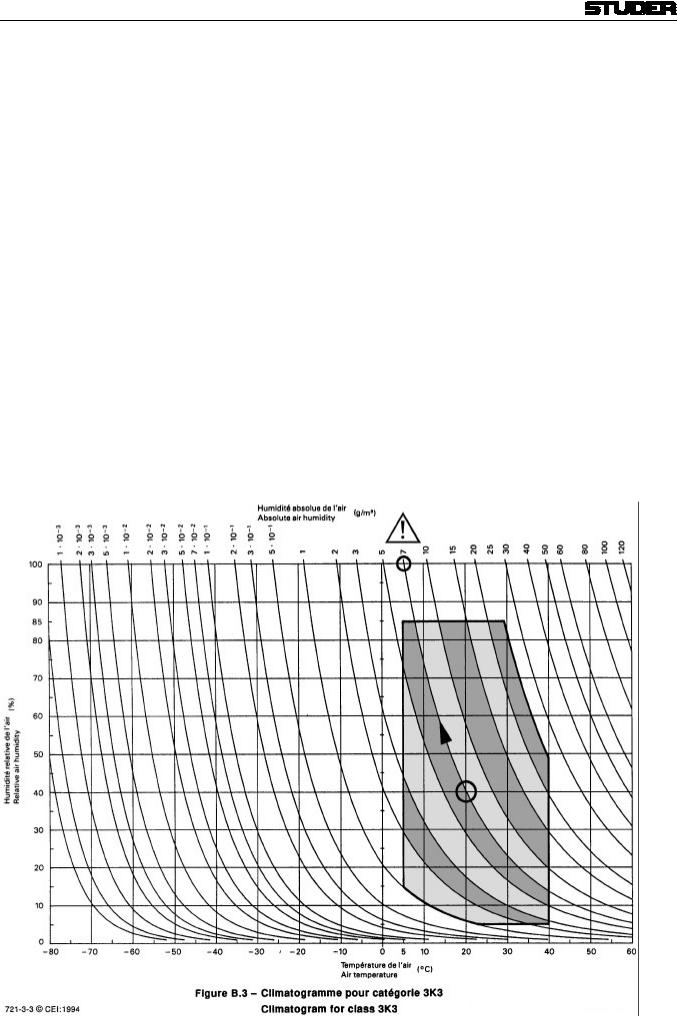
UMGEBUNGSBEDINGUNGEN / AMBIENT CONDITIONS
Vor der Inbetriebnahme muss das System auf allfällige interne Betauung oder Eisbildung überprüft werden. Nur bei sehr leichter Eisbildung kann mit direkter Verdunstung (Sublimation) gerechnet werden; andernfalls muss das System im abgeschalteten Zustand gewärmt und getrocknet werden.
Das System ohne feststellbare interne Eisbildung oder Betauung soll möglichst homogen (und somit langsam) mit eigener Wärmeleistung aufgewärmt werden; die Lufttemperatur der Umgebung soll ständig etwas tiefer als diejenige der Systemabluft sein.
Ist es unumgänglich, das abgekühlte System sofort in warmer Umgebungsluft zu betreiben, so muss diese entfeuchtet sein. Die absolute Luftfeuchtigkeit muss dabei so tief sein, dass die relative Feuchtigkeit, bezogen auf die kälteste Oberfläche im System, immer unterhalb 100% bleibt.
Es ist dafür zu sorgen, dass beim Abschalten des Systems die eingeschlossene Luft möglichst trocken ist (d.h. vor dem Abschalten im Winter den Raum mit kalter, trockener Luft belüften und feuchte Gegenstände, z.B. Kleider, entfernen).
Die Zusammenhänge sind im folgenden Klimatogramm ersichtlich. Zum kontrollierten Verfahren gehören Thermometer und Hygrometer sowie ein Thermometer innerhalb des Systems. Beispiel 1: Ein Ü-Wagen mit einer Innentemperatur von 20 °C und 40% relativer Luftfeuchtigkeit wird am Abend abgeschaltet. Sinkt die Temperatur unter +5 °C, bildet sich Tau oder Eis.
Beispiel 2: Ein Ü-Wagen wird morgens mit 20 °C warmer Luft von 40% relativer Luftfeuchtigkeit aufgewärmt. Auf Teilen, die kälter als +5 °C sind, bildet sich Tau oder Eis.
VI
Before putting into operation, the system must be checked for internal formation of condensation or ice. Only with a minute formation of ice, direct evaporation (sublimation) may be expected; otherwise the system must be heated and dried while switched off.
A system without visible internal formation of ice or condensation should be heated up with its own heat dissipation, as homogeneously (and subsequently as slow) as possible; the ambient temperature should then always be lower than the outgoing air.
If it is absolutely necessary to operate the system immediately within warm ambient air, this air must be dehydrated. In such a case, the absolute humidity must be so low that the relative humidity, related to the coldest system surface, always remains below 100%.
Ensure that the enclosed air is as dry as possible when powering off (i.e. before switching off in winter, aerate the room with cold, dry air, and remove humid objects as clothes from the room).
These relationships are visible from the following climatogram. For a controlled procedure, thermometer and hygrometer as well as a thermometer within the system will be required.
Example 1: An OB-van having an internal temperature of 20 °C and rel. humidity of 40% is switched off in the evening. If temperature falls below +5 °C, dew or ice will be forming.
Example 2: An OB-van is heated up in the morning with air of 20 °C and a rel. humidity of 40%. On all parts being cooler than +5 °C, dew or ice will be forming.

WARTUNG / MAINTENANCE
Wartung und Reparatur
Durch Entfernen von Gehäuseteilen, Abschirmungen etc. werden stromführende Teile freigelegt. Deshalb müssen u.a. die folgenden Grundsätze beachtet werden: Eingriffe in das Gerät dürfen nur von Fachpersonal unter Einhaltung der geltenden Vorschriften vorgenommen werden.
Vor Entfernen von Gehäuseteilen muss das Gerät ausgeschaltet und vom Netz getrennt werden.
Bei geöffnetem, vom Netz getrenntem Gerät dürfen Teile mit gefährlichen Ladungen (z. B. Kondensatoren, Bildröhren) erst nach kontrollierter Entladung, heiße Bauteile (Leistungshalbleiter, Kühlkörper etc.) erst nach deren Abkühlen berührt werden.
Bei Wartungsarbeiten am geöffneten, unter Netzspannung stehenden Gerät dürfen blanke Schaltungsteile und metallene Halbleitergehäuse weder direkt noch mit nichtisoliertem Werkzeug berührt werden.
Zusätzliche Gefahren bestehen bei unsachgemässer Handhabung besonderer Komponenten:
•Explosionsgefahr bei Lithiumzellen, Elektrolyt-Kon- densatoren und Leistungshalbleitern
•Implosionsgefahr bei evakuierten Anzeigeeinheiten
•Strahlungsgefahr bei Lasereinheiten (nichtionisierend), Bildröhren (ionisierend)
•Verätzungsgefahr bei Anzeigeeinheiten (LCD) und Komponenten mit flüssigem Elektrolyt.
Solche Komponenten dürfen nur von ausgebildetem Fachpersonal mit den vorgeschriebenen Schutzmitteln (u.a. Schutzbrille, Handschuhe) gehandhabt werden.
Maintenance and Repair
The removal of housing parts, shields, etc. exposes energized parts. For this reason the following precautions should be observed:
Maintenance should only be performed by trained personnel in accordance with the applicable regulations. The equipment should be switched off and disconnected from the AC power outlet before any housing parts are removed.
Even if the equipment is disconnected from the power, parts with hazardous charges (e.g. capacitors, picture tubes) must not be touched until they have been properly discharged. Touch hot components (power semiconductors, heat sinks, etc.) only when cooled off.
If maintenance is performed on a unit that is opened and switched on, no uninsulated circuit components and metallic semiconductor housings must be touched neither with your bare hands nor with uninsulated tools.
Certain components pose additional hazards:
•Explosion hazard from lithium batteries, electrolytic capacitors and power semiconductors
•Implosion hazard from evacuated display units
•Radiation hazard from laser units (non-ionizing), picture tubes (ionizing)
•Caustic effect of display units (LCD) and such components containig liquid electrolyte.
Such components should only be handled by trained personnel who are properly protected (e.g. safety goggles, gloves).
VII

WARTUNG / MAINTENANCE
Elektrostatische Entladung (ESD) |
Electrostatic Discharge (ESD) |
|
|
bei Wartung und Reparatur |
during Maintenance and Repair |
|
|
|
|
|
|
|
ATTENTION: |
Observe precautions for handling devices sensitive to |
|
|
|
electrostatic discharge! |
|
|
ATTENTION: |
Respecter les précautions d’usage concernant la mani- |
|
|
|
pulation de composants sensibles à l’électricité statique! |
|
|
ACHTUNG: |
Vorsichtsmassnahmen bei Handhabung elektrostatisch |
|
|
|
entladungsgefährdeter Bauelemente beachten! |
|
|
|
|
|
Viele ICs und andere Halbleiter sind empfindlich gegen elektrostatische Entladung (ESD). Unfachgerechte Behandlung von Baugruppen mit solchen Komponenten bei Wartung und Reparatur kann deren Lebensdauer drastisch vermindern.
Bei der Handhabung der ESD-empfindlichen Komponenten sind u.a. folgende Regeln zu beachten:
•ESD-empfindliche Komponenten dürfen ausschliesslich in dafür bestimmten und bezeichneten Verpackungen gelagert und transportiert werden.
•Unverpackte, ESD-empfindliche Komponenten dürfen nur in dafür eingerichteten Schutzzonen (EPA, z.B. Gebiet für Feldservice, Reparaturoder Serviceplatz) gehandhabt und nur von Personen berührt werden, die durch ein Handgelenkband mit Seriewiderstand mit dem Massepotential des Reparaturoder Serviceplatzes verbunden sind. Das gewartete Gerät wie auch Werkzeug, Hilfsmittel, EPAtaugliche (elektrisch halbleitende) Arbeits-, Ablageund Bodenmatten müssen ebenfalls mit diesem Potential verbunden sein.
•Die Anschlüsse der ESD-empfindlichen Komponenten dürfen unkontrolliert weder mit elektrostatisch aufladbaren (Gefahr von Spannungsdurchschlag), noch mit metallischen Oberflächen (Schockentladungsgefahr) in Berührung kommen.
•Um undefinierte transiente Beanspruchung der Komponenten und deren eventuelle Beschädigung durch unerlaubte Spannung oder Ausgleichsströme zu vermeiden, dürfen elektrische Verbindungen nur am abgeschalteten Gerät und nach dem Abbau allfälliger Kondensatorladungen hergestellt oder getrennt werden.
Many ICs and semiconductors are sensitive to electrostatic discharge (ESD). The life of components containing such elements can be drastically reduced by improper handling during maintenance and repair work.
Please observe the following rules when handling ESD sensitive components:
•ESD sensitive components should only be stored and transported in the packing material specifically provided for this purpose.
•Unpacked ESD sensitive components should only be handled in ESD protected areas (EPA, e.g. area for field service, repair or service bench) and only be touched by persons who wear a wristlet that is connected to the ground potential of the repair or service bench by a series resistor. The equipment to be repaired or serviced and all tools, aids, as well as electrically semiconducting work, storage and floor mats should also be connected to this ground potential.
•The terminals of ESD sensitive components must not come in uncontrolled contact with electrostatically chargeable (voltage puncture) or metallic surfaces (discharge shock hazard).
•To prevent undefined transient stress of the components and possible damage due to inadmissible voltages or compensation currents, electrical connections should only be established or separated when the equipment is switched off and after any capacitor charges have decayed.
VIII
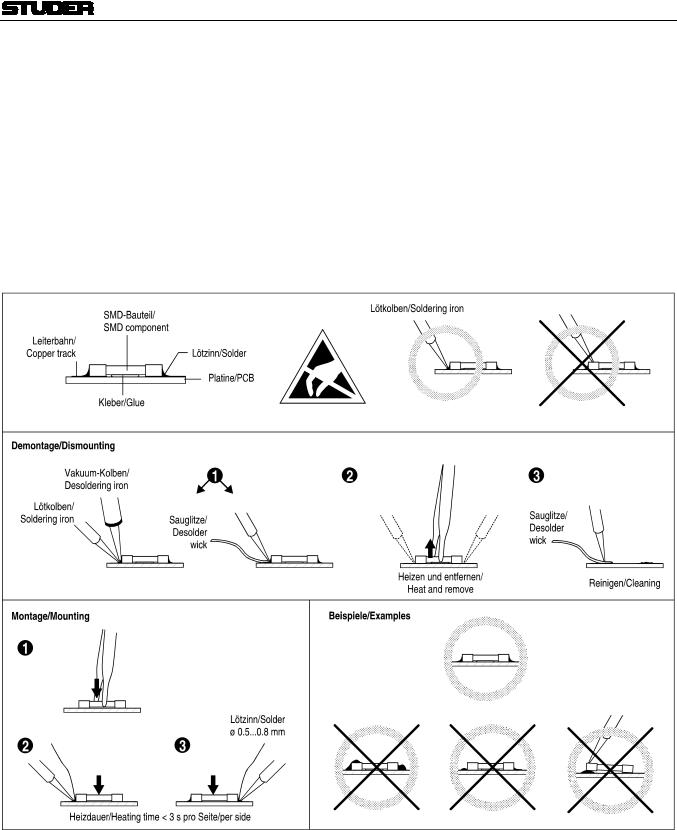
WARTUNG / MAINTENANCE
SMD-Bauelemente |
|
SMD Components |
Der Austausch von SMD-Bauelementen ist ausschliesslich geübten Fachleuten vorbehalten. Für verwüstete Platinen können keine Ersatzansprüche geltend gemacht werden. Beispiele für korrekte und falsche SMDLötverbindungen in der Abbildung weiter unten.
Bei Studer werden keine handelsüblichen SMD-Teile bewirtschaftet. Für Reparaturen sind die notwendigen Bauteile lokal zu beschaffen. Die Spezifikationen von Spezialbauteilen finden Sie in der Serviceanleitung.
SMDs should only be replaced by skilled specialists. No warranty claims will be accepted for circuit boards that have been ruined. Proper and improper SMD soldering joints are depicted below.
Studer does not keep any commercially available SMDs in stock. For repair the corresponding devices should be purchased locally. The specifications of special components can be found in the service manual.
IX

EMV / EMC
Störstrahlung und Störfestigkeit
Das Gerät entspricht den Schutzanforderungen auf dem Gebiet elektromagnetischer Phänomene, wie u.a. in den Richtlinien 89/336/EWG und FCC, Part 15, aufgeführt:
1.Vom Gerät erzeugte elektromagnetische Strahlung ist soweit begrenzt, dass bestimmungsgemässer Betrieb anderer Geräte und Systeme möglich ist.
2.Das Gerät weist eine angemessene Festigkeit gegen elektromagnetische Störungen auf, so dass sein bestimmungsgemässer Betrieb möglich ist.
Das Gerät wurde getestet und erfüllt die Bedingungen der im Kapitel „Technische Daten“ aufgeführten EMVStandards. Die Limiten dieser Standards gewährleisten mit angemessener Wahrscheinlichkeit sowohl den Schutz der Umgebung wie auch entsprechende Störfestigkeit des Gerätes. Absolute Garantie, dass keine unerlaubte elektromagnetische Beeinträchtigung während des Betriebes entsteht, ist jedoch nicht gegeben.
Um die Wahrscheinlichkeit solcher Beeinträchtigung weitgehend auszuschliessen, sind u.a. folgende Massnahmen zu beachten:
•Installieren Sie das Gerät gemäss den Angaben in der Betriebsanleitung, und verwenden Sie das mitgelieferte Zubehör.
•Verwenden Sie im System und in der Umgebung, in denen das Gerät eingesetzt ist, nur Komponenten (Anlagen, Geräte), die ihrerseits die Anforderungen der obenerwähnten Standards erfüllen.
•Sehen Sie ein Erdungskonzept des Systems vor, das sowohl die Sicherheitsanforderungen (die Erdung der Geräte gemäss Schutzklasse I mit einem Schutzleiter muss gewährleistet sein), wie auch die EMV-Belange berücksichtigt. Bei der Entscheidung zwischen sternoder flächenförmiger bzw. kombinierter Erdung sind Vorund Nachteile gegeneinander abzuwägen.
•Benutzen Sie abgeschirmte Kabel, wo vorgesehen. Achten Sie auf einwandfreie, grossflächige, korrosionsbeständige Verbindung der Abschirmung zum entsprechenden Steckeranschluss und dessen Gehäuse. Beachten Sie, dass eine nur an einem Ende angeschlossene Kabelabschirmung als Sendebzw. Empfangsantenne wirken kann (z.B. bei wirksamer Kabellänge von 5 m oberhalb von 10 MHz), und dass die Flanken digitaler Kommunikationssignale hochfrequente Aussendungen verursachen (z.B. LSoder HC-Logik bis 30 MHz).
•Vermeiden Sie Bildung von Masseschleifen oder vermindern Sie deren unerwünschte Auswirkung, indem Sie deren Fläche möglichst klein halten und den darin fliessenden Strom durch Einfügen einer Impedanz (z.B. Gleichtaktdrossel) reduzieren.
Electromagnetic Compatibility
The equipment conforms to the protection requirements relevant to electromagnetic phenomena that are listed in the guidelines 89/336/EC and FCC, part 15.
1.The electromagnetic interference generated by the equipment is limited in such a way that other equipment and systems can be operated normally.
2.The equipment is adequately protected against electromagnetic interference so that it can operate cor-
rectly.
The unit has been tested and conforms to the EMC standards applicable to residential, commercial and light industry, as listed in the section „Technical Data“. The limits of these standards reasonably ensure protection of the environment and corresponding noise immunity of the equipment. However, it is not absolutely warranted that the equipment will not be adversely affected by electromagnetic interference during operation.
To minimize the probability of electromagnetic interference as far as possible, the following recommendations should be followed:
•Install the equipment in accordance with the operating instructions. Use the supplied accessories.
•In the system and in the vicinity where the equipment is installed, use only components (systems, equipment) that also fulfill the above EMC standards.
•Use a system grounding concept that satisfies the safety requirements (protection class I equipment must be connected with a protective ground conductor) that also takes into consideration the EMC requirements. When deciding between radial, surface or combined grounding, the advantages and disadvantages should be carefully evaluated in each case.
•Use shielded cables where shielding is specified. The connection of the shield to the corresponding connector terminal or housing should have a large sur-
face and be corrosion-proof. Please note that a cable shield connected only single-ended can act as a transmitting or receiving antenna (e.g. with an effective cable length of 5 m, the frequency is above 10 MHz) and that the edges of the digital communication signals cause high-frequency radiation (e.g. LS or HC logic up to 30 MHz).
•Avoid ground loops or reduce their adverse effects by keeping the loop surface as small as possible, and reduce the noise current flowing through the loop by inserting an additional impedance (e.g. commonmode rejection choke).
X
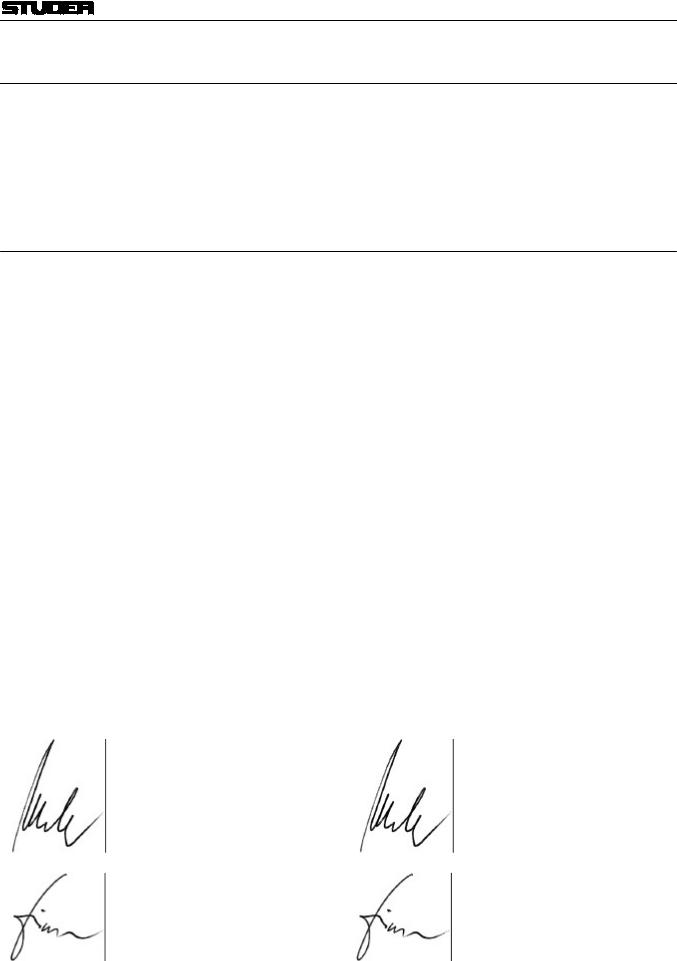
Konformitätserklärungen / Declarations of conformity
Class A Equipment - FCC Notice
This equipment has been tested and found to comply with the limits for a Class A digital device, pursuant to Part 15 of the FCC Rules. These limits are designed to provide a reasonable protection against harmful interference when the equipment is operated in a commercial environment. This equipment generates, uses, and can radiate radio frequency energy and, if not installed and used in accordance with the instruction manual, may cause harmful interference to radio communications. Operation of this equipment in a residen-
tial area is likely to cause harmful interference in which case the user will be required to correct the interference at his own expense.
Caution:
Any changes or modifications not expressly approved by the manufacturer could void the user's authority to operate the equipment. Also refer to relevant information in this manual.
CE-Konformitätserklärung |
|
CE Declaration of Conformity |
Der Hersteller,
Studer Professional Audio AG,
CH-8105 Regensdorf,
erklärt in eigener Verantwortung, dass das Produkt
Studer D19 MicVALVE, Valve Dignified Mic/Line Preamplifier, (ab Serie-Nr. 101),
auf das sich diese Erklärung bezieht, entsprechend den Bestimmungen der EU-Richtlinien und Ergänzungen
•Elektromagnetische Verträglichkeit (EMV): 89/336/EWG + 92/31/EWG + 93/68/EWG
•Niederspannung: 73/23/EWG + 93/68/EWG
mit den folgenden Normen und normativen Dokumenten übereinstimmt:
•Sicherheit:
Schutzklasse 1, EN 60950:1992 + A1/A2:1993
•EMV:
EN 50081-1:1992, EN 50082:1992.
Regensdorf, 6. Februar 1996
B. Hochstrasser, Geschäftsleiter
P. Fiala, Leiter QS
The manufacturer,
Studer Professional Audio AG,
CH-8105 Regensdorf,
declares under his sole responsibility that the product
Studer D19 MicVALVE, Valve Dignified Mic/Line Preamplifier, (on from serial No. 101),
to which this declaration relates, according to following regulations of EU directives and amendments
•Electromagnetic Compatibility (EMC): 89/336/EEC + 92/31/EEC + 93/68/EEC
•Low Voltage (LVD): 73/23/EEC + 93/68/EEC
is in conformity with the following standards or other normative documents:
•Safety:
Class 1, EN 60950:1992 + A1/A2:1993
•EMC:
EN 50081-1:1992, EN 50082:1992.
Regensdorf, February 6, 1996
B. Hochstrasser, Managing director
P. Fiala, Manager QA
XI

|
|
|
|
|
|
|
|
|
|
|
|
D19 MicVALVE |
|
|
|
|
|
|
|
|
|
|
|
|
|
|
|
|
|
|
|
|
|
|
|
|
|
|
|
|
|
|
|
|
|
|
|
|
|
|
|
|
|
|
|
|
|
|
|
|
|
|
|
|
CONTENTS |
|
|||||||||||
1 |
|
|
|
Come in!................................................................................................................................................................. |
E1/1 |
|||||||
|
1.1 |
Basic Information ............................................................................................................................................ |
E1/1 |
|||||||||
|
1.2 |
General............................................................................................................................................................ |
E1/2 |
|||||||||
|
1.2.1 |
|
|
|
|
Scope of Delivery..................................................................................................................................... |
E1/2 |
|||||
|
1.2.2 |
|
|
|
|
Options .................................................................................................................................................... |
E1/2 |
|||||
|
1.2.3 |
|
|
|
|
Accessories .............................................................................................................................................. |
E1/2 |
|||||
|
1.3 |
Safety and Connections.................................................................................................................................... |
E1/3 |
|||||||||
|
1.3.1 |
|
|
|
|
Utilization for the Purpose Intended ......................................................................................................... |
E1/3 |
|||||
|
1.3.2 |
|
|
|
|
Power Connection .................................................................................................................................... |
E1/3 |
|||||
|
|
|
|
|
|
Connector Panel .................................................................................................................................................. |
E1/4 |
|||||
|
1.4 |
Technical Specifications .................................................................................................................................. |
E1/6 |
|||||||||
|
1.4.1 |
|
|
|
|
Audio Specifications ................................................................................................................................ |
E1/6 |
|||||
|
1.4.2 |
|
|
|
|
Synchronization ....................................................................................................................................... |
E1/7 |
|||||
|
1.4.3 |
|
|
|
|
Power Supply........................................................................................................................................... |
E1/7 |
|||||
|
1.4.4 |
|
|
|
|
Primary Fuse............................................................................................................................................ |
E1/8 |
|||||
|
1.4.5 |
|
|
|
|
Operating Conditions............................................................................................................................... |
E1/8 |
|||||
|
1.4.6 |
|
|
|
|
Safety and EMC Standards....................................................................................................................... |
E1/8 |
|||||
|
1.4.7 |
|
|
|
|
Mechanical Data ...................................................................................................................................... |
E1/8 |
|||||
2 |
|
|
|
Operation............................................................................................................................................................... |
E2/1 |
|||||||
|
2.1 |
|
Operating Elements......................................................................................................................................... |
E2/1 |
||||||||
|
2.2 |
|
Audio and Sync Connections, Pin Assignments............................................................................................... |
E2/4 |
||||||||
|
2.2.1 |
|
|
|
|
Mic and Line Inputs, Insert Returns......................................................................................................... |
E2/4 |
|||||
|
2.2.2 |
|
|
|
|
Line Outputs, Insert Sends ....................................................................................................................... |
E2/4 |
|||||
|
2.2.3 |
|
|
|
|
AES/EBU, Digital Output........................................................................................................................ |
E2/4 |
|||||
|
2.2.4 |
|
|
|
|
AES IN, External AES/EBU Synchronization.......................................................................................... |
E2/4 |
|||||
|
2.2.5 |
|
|
|
|
Word Clock In/Out .................................................................................................................................. |
E2/4 |
|||||
|
2.2.6 |
|
|
|
|
Using the TDIF-1 8-Channel Interface..................................................................................................... |
E2/5 |
|||||
|
2.2.7 |
|
|
|
|
Using the Optical ADAT 8-Channel Interface.......................................................................................... |
E2/6 |
|||||
|
2.3 |
Application Ideas and Examples ...................................................................................................................... |
E2/7 |
|||||||||
|
2.3.1 |
|
|
|
|
Wiring for External Synchronization ....................................................................................................... |
E2/9 |
|||||
3 |
|
|
|
Additional information.......................................................................................................................................... |
E3/1 |
|||||||
|
3.1 |
What the Heck is Noise Shaping? .................................................................................................................... |
E3/1 |
|||||||||
|
3.2 |
Block Diagrams............................................................................................................................................... |
E3/3 |
|||||||||
|
3.2.1 |
|
|
|
|
Global Audio Block Diagram ................................................................................................................... |
E3/3 |
|||||
|
3.2.2 |
|
|
|
|
Synchronization Block Diagram............................................................................................................... |
E3/3 |
|||||
Date printed: 9.2.2000 |
Contents E0/1 |
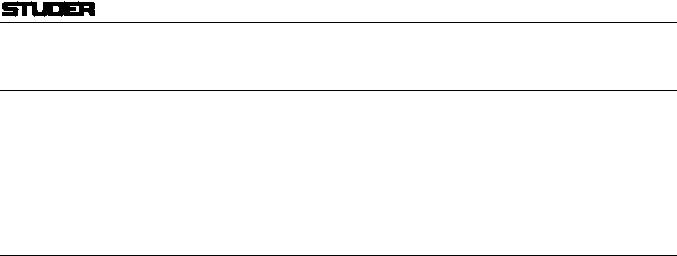
D19 MicVALVE
1 COME IN!
We are happy to welcome you in the steadily growing circle of the Studer D19 MicVALVE's users, and we felicitate you on your selection. Thanks to Studer's experience collected during more than 40 years of business in the professional audio products field, you may expect that the performance of your new unit will fulfill your highest demands.
1.1Basic Information
Together with the renaissance of natural sounds and the classical recorded performance of real artists (as opposed to computer-gernerated sounds), users frequently quote the term “valve sound” in a meaning far beyound nostalgic reminiscence. Studer engineers have systematically investigated the differences between valve and transistor amplifiers. The result of this research is now part of the D19 MicVALVE, where the typical properties of valve amplifiers are implemented in the form of adjustable parameters.
The MicVALVE is a two-channel preamplifier for microphone and line level signals with analog and digital outputs. The main signal path is designed in semiconductor technology and allows top quality “direct-to-digital” recordings. A Valve Dignifier stage equipped with 2 × ECC 81 valves per channel can be switched into the signal path, providing a number of front panel controls for individual valve sound treatment. Each input has a switchable analog insert and an analog output. Both channels are then combined to an AES/EBU digital output. The built-in 20 bit A/D converter technology represents today's state of the art. Thanks to the modular concept the A/D converter can easily be upgraded as technology advances. A TDIF or an optical ADAT interface can be installed as an option.
Even in connection with recording media having only the reduced 16 bit resolution, the Studer MicVALVE leads to improved results thanks to DSP dithering and noise shaping technology which is used instead of simple truncating.
Date printed: 9.2.2000 |
Come in! E1/1 |

D19 MicVALVE
1.2General
1.2.1Scope of Delivery
The D19 MicVALVE (order No. 66.655.000.00) is supplied with an IEC 320/C13 socket, a hex-socket-screwdriver (2.5 mm), and this manual.
1.2.2 |
Options |
|
Order No. |
Digital Audio Output Options: |
|
|
|
|
ADAT Interface: |
8-channel optical digital audio output card |
1.650.050.20 |
|
|
for connecting with the ADAT and compatible |
|
|
|
8-channel recorders or other equipment featuring |
|
|
|
the ADAT standard connectors. |
|
|
TDIF-1 Interface: |
8-channel digital audio output card |
1.650.052.20 |
|
|
for connecting with the DA-88 and compatible |
|
|
|
8-channel recorders or other equipment featuring |
|
|
|
the TDIF-1 standard connectors. |
|
|
Note: |
These two options are identical to the ones used for the eight-channel D19 |
|
|
|
MicAD preamp; the channel routing, however, can be selected individually |
|
|
|
on the D19 MicVALVE. |
|
|
Super ADC: |
Converter assembly for further improving |
1.655.042.00 |
|
|
the A/D performance |
|
1.2.3 |
Accessories |
|
Order No. |
|
Accessories/Spares: |
Kit, consisting of: |
20.020.302.51 |
|
|
• Mating XLR connectors (7 pcs. male, |
|
|
|
5 pcs. female) |
|
|
|
• Rotary knobs (2 × small, 1 × large) |
|
|
|
• Rack mounting screws with washers |
|
|
|
(4 pcs. each) |
|
|
Interface cables: |
ADAT/Alesis optical interface cable, |
10.325.010.00 |
|
|
length 1.0 m |
|
|
|
ADAT/Alesis optical interface cable, |
10.325.011.00 |
|
|
length 5.0 m |
|
|
|
TDIF-1/Tascam interface cable |
F-10.025.031.08 |
|
|
|
“PW 88D”, length 1.0 m |
|
|
TDIF-1/Tascam interface cable |
F-10.025.031.09 |
|
|
“PW 88D”, length 5.0 m |
|
E1/2 Come in! |
|
Date printed: 9.2.2000 |
|
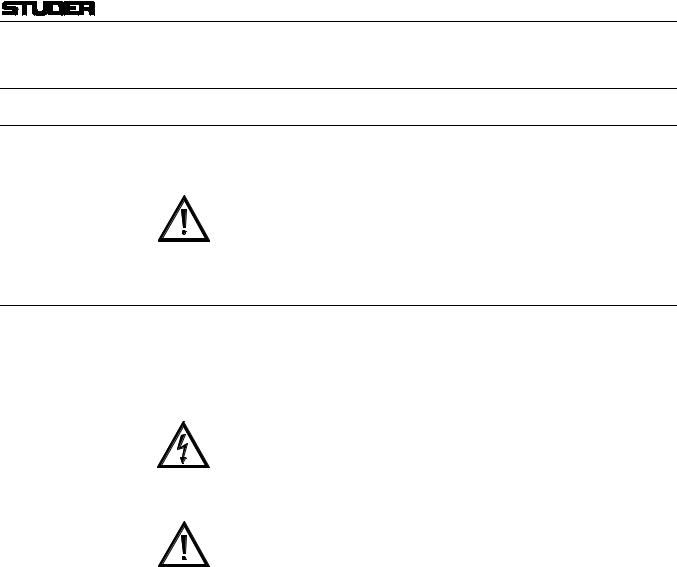
D19 MicVALVE
1.3Safety and Connections
1.3.1Utilization for the Purpose Intended
The Studer D19 MicVALVE 2-channel Mic/Line valve preamplifier is designed for professional use. It is presumed that the unit is operated only by trained personnel; servicing must be performed by qualified experts.
The electrical connections may be connected only to the appropriate voltages and signals specified in this manual. Please consult the Security and EMC section at the very beginning of this manual.
1.3.2Power Connection
There is no need to select a specific mains voltage setting because the Studer D19 MicVALVE can be operated on mains voltages from 100 through 240 VAC, 50...60 Hz.
Danger: Repair work may only be performed by a trained service technician. The primary fuse of the D19 MicVALVE must be replaced by a spare fuse of exactly the same type. The D19 MicVALVE must not be opened by the user
– the risk of a severe electric shock hazard is increased as a result of the high operating voltage of the vacuum tubes (300 V)!
Power cable: The supplied power socket has to be fitted with a mating power cable incl. plug by an electrician, if your local Studer agency or your dealer should not
have added a fitting power cable.
Please consult the Safety section at the very beginning of this manual.
Date printed: 9.2.2000 |
Come in! E1/3 |
